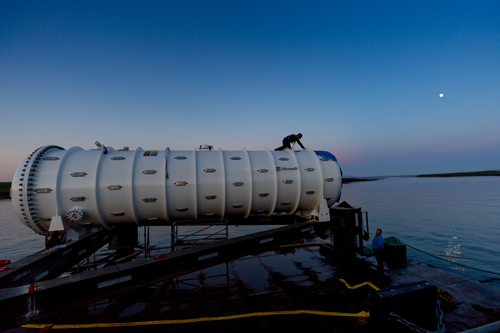News
Microsoft's Underwater Datacenter Project Hits 'Phase 2'
- By Kurt Mackie
- June 07, 2018
"Project Natick," Microsoft's experimental datacenter that cools itself by being immersed under ocean waters, has reached the next phase of development.
As Microsoft described this week, Phase 2 of Project Natick tests the practical aspects of deploying a full-scale datacenter under harsher conditions compared to Phase 1 back in 2015. That phase involved a smaller prototype being placed in shallow waters off the coast of California.
This time, Microsoft picked the coast off the Orkney Islands of Scotland for the Phase 2 subsea deployment, where 10-foot wave sea conditions are the norm. The cooling takes place from the temperature under the water. No seawater gets pumped to cool the servers.
While the Phase 1 datacenter had the computing power of 300 PCs, Phase 2's computing power is equivalent to "several thousand high-end consumer PCs," according to Microsoft's FAQ page. The datacenter of Phase 2 is 40 feet in length, consisting of 12 racks with 864 servers that was placed inside a submarine-like container and dropped 117 feet to the sea floor atop a triangular metal platform. The Phase 2 datacenter can house 27.6 petabytes of data.
Phase 2 is powered by the Orkney Islands' local grid electricity, which is produced by renewable wind, solar and tidal sources. However, one of the goals of the project is to test powering the datacenter with an off-the-grid source, such as using nearby tidal power. Possibly, the two technologies could evolve together, Microsoft's announcement speculated.
 [Click on image for larger view.] Microsoft prepares to deploy the Project Natick datacenter off the coast of Scotland's Orkney Islands. (Source: Microsoft)
[Click on image for larger view.] Microsoft prepares to deploy the Project Natick datacenter off the coast of Scotland's Orkney Islands. (Source: Microsoft)
Microsoft wants to try putting datacenters offshore because about half the world's population lives near the coast. A nearby datacenter reduces latency for bandwidth-intensive applications such as video streaming and gaming, as well as emerging artificial intelligence-powered apps.
Microsoft is testing the economics and practicality of deploying datacenters in this way. Phase 2 has already proved that it's possible to deploy an undersea datacenter in less than 90 days "from factory ship to operation." While Project Natick (code-named after the Massachusetts city) is considered to be an early "moonshot" effort at this point, Microsoft expects to gain valuable knowledge from the project, whether it goes into mass production or not.
For instance, Microsoft expects to gain datacenter knowledge from Project Natick, according to Peter Lee, corporate vice president of Microsoft AI and Research. He also leads the New Experiences and Technologies (NExT) group.
"When you go for a moonshot, you might not ever get to the moon," Lee said in Microsoft's announcement. "It is great if you do, but, regardless, you learn a lot and there are unexpected spinoffs along the way. You get Velcro at some point. That is happening in this case. We are learning about disk failures, about rack design, about the mechanical engineering of cooling systems and those things will feedback into our normal datacenters."
The Phase 2 datacenter is expected to last under the sea without maintenance for five years. After that time, it'll get pulled up to replace the servers. Artificial intelligence is used to check operations for any failures. Possibly, the datacenter could be good for 20 years under the sea. Microsoft and its partners have designed everything in Project Natick to be recyclable.
The datacenter was designed by the Naval Group of France and was deployed at European Marine Energy Centre of Scotland.
About the Author
Kurt Mackie is senior news producer for 1105 Media's Converge360 group.